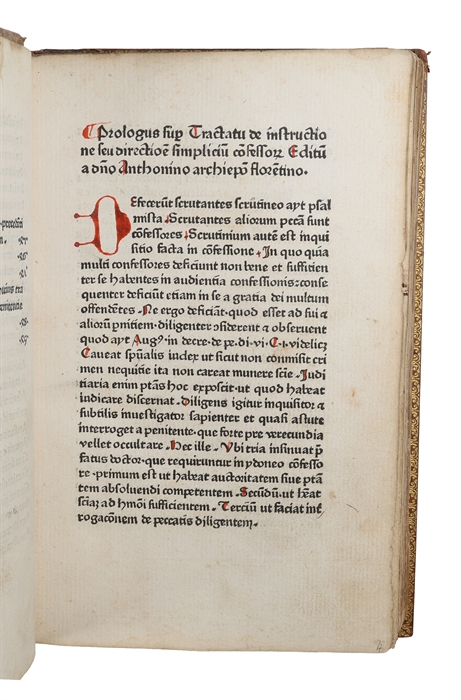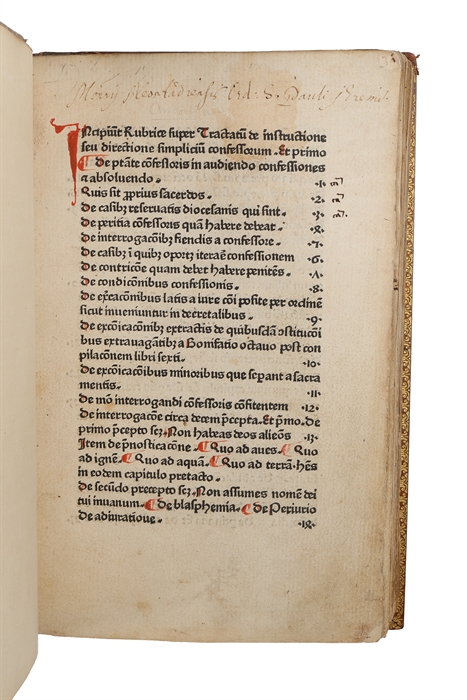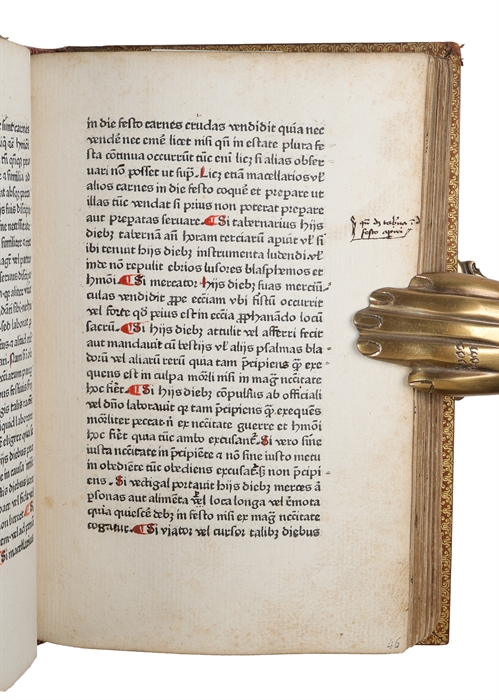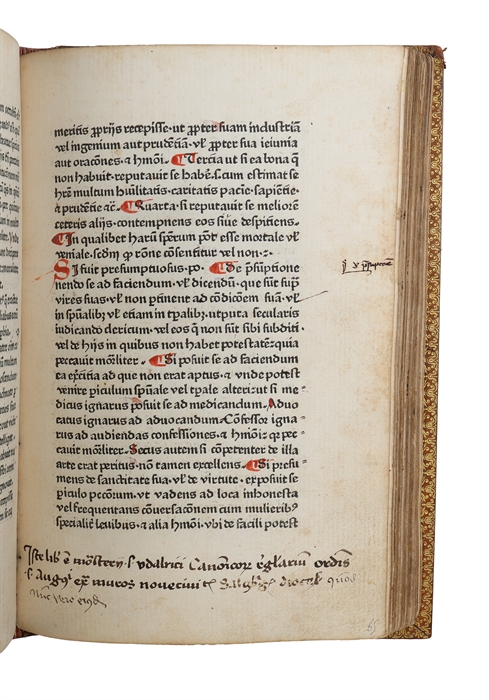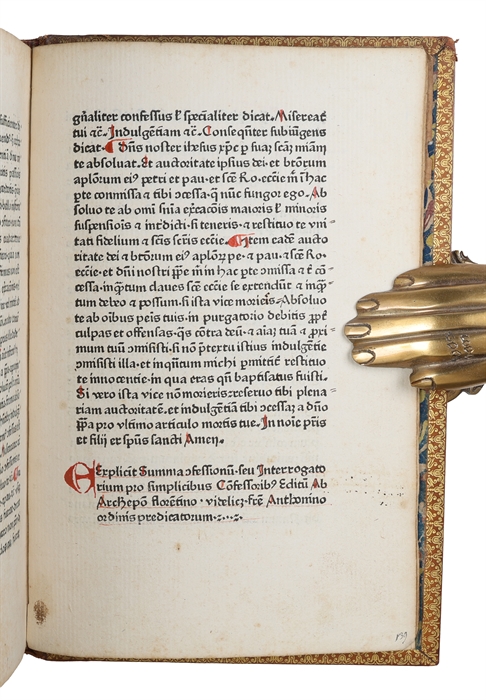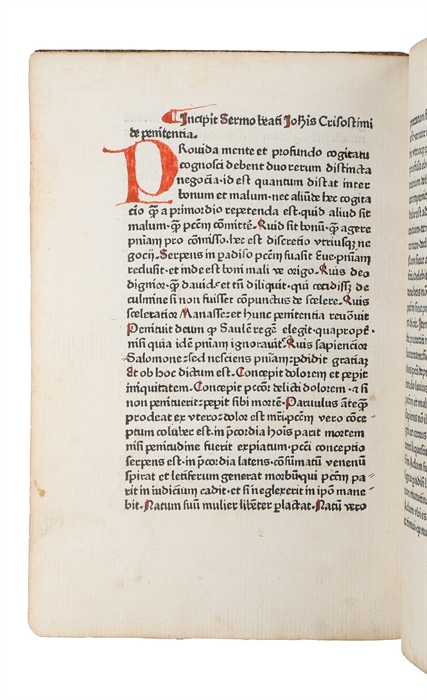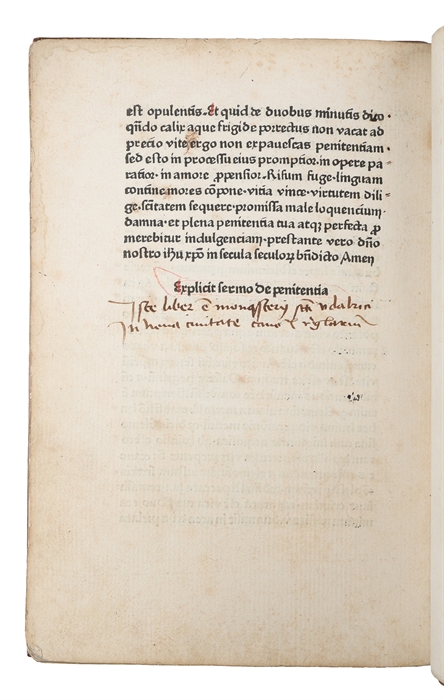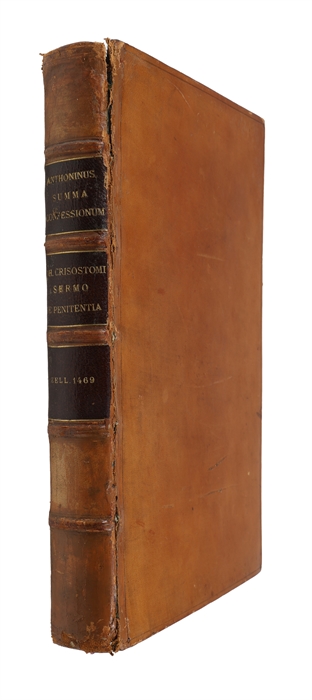ONE OF THE MOST INFLUENTIAL CONFESSION BOOKS OF THE CATHOLIC CHURCH
ANTONINUS FLORENTINUS + (PSUDO-) JOHANNES CHRYSOSTOMUS.
Confessionale ("Defecerunt"...) + Sermo de poenitentia.
(Köln (Cologne), Ulrich Zell / Zel, ca. 1469).
Large 8vo. Block measuring 21,5 x 14 cm. Printed in Gothic type, 27 lines to a page,
Bound in a beautiful 19th century full polished calf with five raised bands to spine, gilt title-labels, inner gilt dentelles, and all edges of boards gilt. The hinges are worn and weak and cracked at the top. Marbled end-papers. Inside of front board with the book plate of Gilbert R. Redgrave. 144 ff. (including final blank). Internally a
The first leaf is with a slightly later 15th century handwritten inscription stating the provenance of the copy: "Mo[aste]rii Neostadiensis Ord[inis] S. Pauli Eremit[ae]" (i.e. Order of Saint Paul the First Hermit, Monastery in Neustadt), being the Pauliner-monastery in Wiener Neustadt outside of Vienna.
There are two further inscriptions, both in contemporary hand, presuambly the same as that of the marginal notes throughout. They are on f. (65r) and f. (143v) and state that the book belongs to the Augustinian order of the St. Ulrich-Kloster ("mo[na]sterii S. Udalrici") in Wiener Neustadt.
Exceedingly scarce early incunable-printing, possibly the first printing of both texts, being Antoninus’ “Confessionale” (the one known under the incipit “Defecerunt scrutantes scrutineo” (f. 4r) – one of the most influential confession books ever written, on the powers of the confessor, the seven deadly sins, the manner of interrogating persons of varying status, and absolution and the imposition of penance -, together with (Pseudo-) Chrysostomos’ “Sermo de Peonitentia” The venerated Catholic saint, Dominican friar, and Archbishop of Florence Antoninus Florentinus (1389-1459) had a great reputation for theological learning and had assisted as a papal theologian at the Council of Florence. Hist most important works – both written before and printed before his Summa Theologica -, are arguably his guides for confessors, which for centuries were highly regarded by the clergy as an aid and constituted a major development in the field of moral theology. Antoninus published three separate works that are all entitled “Confessionale”. They are distinguished by their incipit, the present being “Defecerunt…”, the most fundamental and influential of the three. The two others have “Curam illius habe”, also known as the “Specchio di coscienza”, which is an instruction manual for the sacrament of confession, written in Italian for a Neapolitan gentleman, directed at advising lay men and women, and “Curam illius habe,” also known as the “Medicina dell’anima”, which is an instruction manual directed to priests. Unlike the other two manuals, the “Defecerunt…” was published in Latin. It was “completed before July of 1440. This latter work is Antonin’s most popular by far, to judge by the number of manuscript copies, printed editions, and vernacular translations (Italian, Spanish, Croatian).” (Jason A. Brown: St Antonin of Florence..., 2019, pp. 44-45). Printed together with the “Defecerunt” Confessionale is the important “Sermo de poenitentia”, long ascribed to Chrysostomos, in which he deals with penance, also possibly printed here for the first time. The printing history of the work is quite complicated. There is no date and no printing place in the earliest printings of this foundational Catholic work, and numerous versions of it were printed. Furthermore, much of the “Defecerunt” seems to have been incorporated into his later, also highly influential “Summa” (see 3.17 – de statu confessorum). “The Confessionale “Defecerunt” exists in two known recensions, a briefer and a longer. These are distinguished by their incipits. The briefer recension incipit: Defecerunt scrutantes scrutinio ... Scrutantes aliorum peccata sunt confessores. Scrutinium autem est inquisitio facta in confessione. The longer recension incipit: Defecerunt scrutantes scrutinio ... Scrutinium quidem est confessio, in quo et penitens scrutatur conscientiam suam et confessor cum eo. It would be a tenable hypothesis, a priori, that the longer recension is original, that its material was copied into the Summa at the relevant places, and that the briefer recension was produced by abbreviating the longer one. Having examined early printed editions of the “Defecerunt” and considered their text against the autograph manuscripts, I consider it more likely that the longer recension is the later one, and represents an expanded version produced by adding in material from the Summa at corresponding places in the original Confessionale.” (Jason A. Brown: St Antonin of Florence..., 2019, p. 112). The present version – arguably the earliest – is the briefer, which was then later elaborated upon. As all bibliographers agree, it is clear from the characters that this copy was printed by Zell in Køln (Cologne), and no later than 1469 (some say no later than 1468, some just state “ca. 1470”)). Zell printed more than one version around the same time, but this seems to be the first of them – corresponding exactly to Hain 1162. In all, between 50 and 60 incunable editions of the work appeared in Latin, along with editions in Italian and Spanish, testifying to the enormous impact the work came to have on Catholic penitence. According to Gesamtkatalog der Wiegendrucke, 44 copies, including single fragments, are known to exist in public holdings, and at least one copy is known to exist on private hands. Hain-Copinger: 1162; GW: 2082; Brunet: I:333; Graesse I: 154.
Provenance: During the reign of the pietist Habsburger Friedrich III (1440-1493), the small town of Wiener Neustadt near Vienna witnessed a blossoming of new clerical orders. They were more than doubled. To the already established monasteries were added, among several others, both an Augustiner-Kloster (which took over St. Ulrich), in 1459, and the Paulinerkloster (the one for St. Paul the First Hermit), in 1480. As is evident from the inscriptions in the present copy, it has belonged to both these orders, the first of which will presumably have acquired it at its appearance, where it was thoroughly read and annotated. With a decree of December 20th 1459, Pope Pius II allowed for a Augustinian Canon-monastery in Wiener Neustadt and thus fulfilled a longstanding wish of Kaiser Friedrich III. In June 1459, a decisive prerequisite for the founding of this monastery had taken place – the Secular Canons had renounced their parish church St. Ulrich in the Western suburb of Wiener Neustadt, which was now at the disposal for the Augustinian Canons. Friedrich III had very specific requests for the Augustinian Canons of Wiener Neustadt, and in accordance with these, Pope Pius II prescribed a dress for them that differed from the usual colour. Instead of a white habit, they were to wear a brown habit with a gold-coloured cross on the right side; the almucium (fur shoulder cloak), worn over the habit, was to be white on feast days and in church (instead of the usual black), while on ordinary days and outside of church, a brown almucium was to be worn. Like the provost of the secular canons, the provost of the Augustinian Canons also had the right to pontificals. The founding of the Augustinian Canons' foundation is recorded in a relief on Friedrich III’s tomb in the St. Stephan Cathedral in Vienna. On both sides of St. Ulrich, enthroned in the center, kneels an infulated priest, presumably the provost and dean. This group is surrounded by thirteen (also kneeling) canons. The inscription reads: "CANONICI REGULARES S. ULRICI NOVE CIVITATIS."
Order-nr.: 62151

